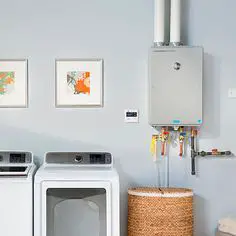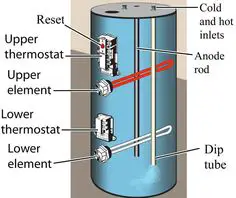You may be wondering, “Do I need to worry about my electric water heater clearance requirements?” The answer is yes. Clearances for your water heater are important and they vary by region. In this blog post, we’ll discuss the various electrical equipment codes and regulations that determine how close you can put an electric water heater near a combustible surface such as wood or drywall.
Electric Water Heater Clearance Requirements
The electric water heater clearance requirements are based on several factors.
- The first is the size of your room. The larger the space, the more clearance you need between the heater and any combustible items.
- Next is how many inches high you want to keep it off of the ground. You can install Electric heaters at a height that works best for your needs. But again they must meet certain requirements depending on their size.
- You also need to keep in mind that there are specific clearance requirements for the gas line and wire. That runs into your electric heater. Because of this, heaters may not be installed closer than one foot from a sidewall. Or closer than three feet from an exterior wall unless it is within 18 inches of another appliance venting horizontally through outside walls.
- The heater must be at least three feet from the floor unless it is within 18 inches of another vent through the exterior walls. Or within one foot of all other heating appliances.
- Electric water heaters need to have two clearance areas with different requirements based on their location in your home. First, there should be a six-inch space between the front and sides of the electric heater to allow for ventilation. Second, there should be a 12-inch space between the back and rear. And any combustible materials, such as walls and furniture in your home.
If you have additional questions about clearance requirements for an electric water heater in your specific situation. Please refer to NFPA 70: National Electric Code and contact a local service professional. Remember that the requirements for the gas or electric model are different.
Electric Water Heaters vs Gas-fired Water Heaters Clearance Requirements
The clearance requirements are typically based on size, location of the room, height off of the ground, etc. Moreover, there are specific gas line/wire clearances as well. The electric water heater tank needs to have at least six inches between the front sides with the ventilation required. Also, you must keep them away from combustible materials by at least 12 inches (back or rear). And at three feet off the ground unless within 18 of another vent through exterior walls. However tankless heaters also have their own sets of clearance space needed.
How Much Air Space Do You Need Around a Water Heater?
The minimum air space required around an electric water heater is six inches on all sides. Similarly, they need to have at least six inches between the front sides with the ventilation required. Moreover, you need 12 inches between the air ducts, and any combustible materials. Electric heaters unlike gas units need to be three feet off of the ground. Unless within the 18-inch range from another vent through exterior walls or one foot for all other heating appliances.
Furthermore, gas water heaters have a different set of requirements so check out for those if you are interested.

The Five Clearances for Maintenance and Replacement of a Hot Water Heater
The five clearances for the maintenance and replacement of an electric hot water heater are based on:
- The size of your room,
- Location in your home,
- Height off of the ground (if applicable),
- How many inches high do you want to keep it off of the ground,
- Specific gas line/wire clearance.
The six-inch space between the front sides with ventilation is necessary. Moreover, you require a minimum clearance of 12 inches between the back and any combustible materials for an electric water heater.
They must also be kept away from combustible materials by at least six inches on all sides, or three feet off of the ground. Unless within an 18-inch range to another vent through exterior walls or one foot for other heating appliances.
Can You Enclose Water Heaters?
No, you cannot enclose water heaters. Because they require a minimum clearance of at least six inches between the front sides with ventilation required. In addition 12 inches between the back and any combustible materials. Heaters also should be three feet off of the ground. Unless within an 18-inch range from another vent through exterior walls or one foot for all other heating appliances.
Electric Water Heater Installation
Installing a tank water heater might seem easy. However some of these common problems are the main reason why homeowners often call for professional help.
Common Problems Include:
- Leaks due to loose fittings or improperly sealed connections
- Broken parts from a freeze, shock, vibration, poor installation, or earthquake.
- Faulty temperature relief valve or drain pan
- Damaged wiring or loose connections
- Corrosion, sediment buildup at the bottom of the tank, and scale build-up due to hard water
- A loose gas connection can result in carbon monoxide poisoning if not properly sealed.
FAQs: Electric Water Heater Clearance Requirements
Do Electric Water Heaters Need to be Elevated?
Yes, electric water heaters need elevation off the ground because of their specific gas line/wire clearance. For safety purposes, they should be at least three feet off of the ground and within an 18-inch range from another vent through exterior walls.
What are the Electric Tankless Water Heater Clearance Requirements?
For a safe installation of electric tankless water heaters, they should meet the following clearances. Six inches from the front side with ventilation required. 12 inches from the back and any combustible materials. Three feet off of the ground unless within 18-inch range to another vent through the exterior.
Is It Necessary to Strap Electric Water Heaters?
To make sure your water heater is safe, it needs to be strapped. Straps can either have plumber’s tape or a half-inch diameter metal conduit and one should wrap around the upper third of its fixture while another goes lower on both sides as well.
Can You Put the Water Heater on Bricks?
A couple of bricks or large concrete blocks (2x8x16″) are always enough to mount a water heater. However, most of the houses I work in are older and have water problems, so keeping it a few inches above the ground is always a good idea.
What are the Electric Water Heater Closet Dimensions?
Electric water heater closet dimensions vary from one manufacturer to another. Make sure you check the appliance’s user manual before installing it in a tight or small closet.
Conclusion
If you’re not sure about your water heater’s clearance requirements, contact a professional in the area. It may be worth it to invest in an electrician if the price is right. In addition, they can help ensure that there are no issues with your water heater setup.
You don’t want any surprises when your hot water stops working one day because someone did not install something correctly. Let us know what we can do to help you out and our team of experts will take care of everything so that you don’t have to worry about anything but enjoying some much-needed downtime.

